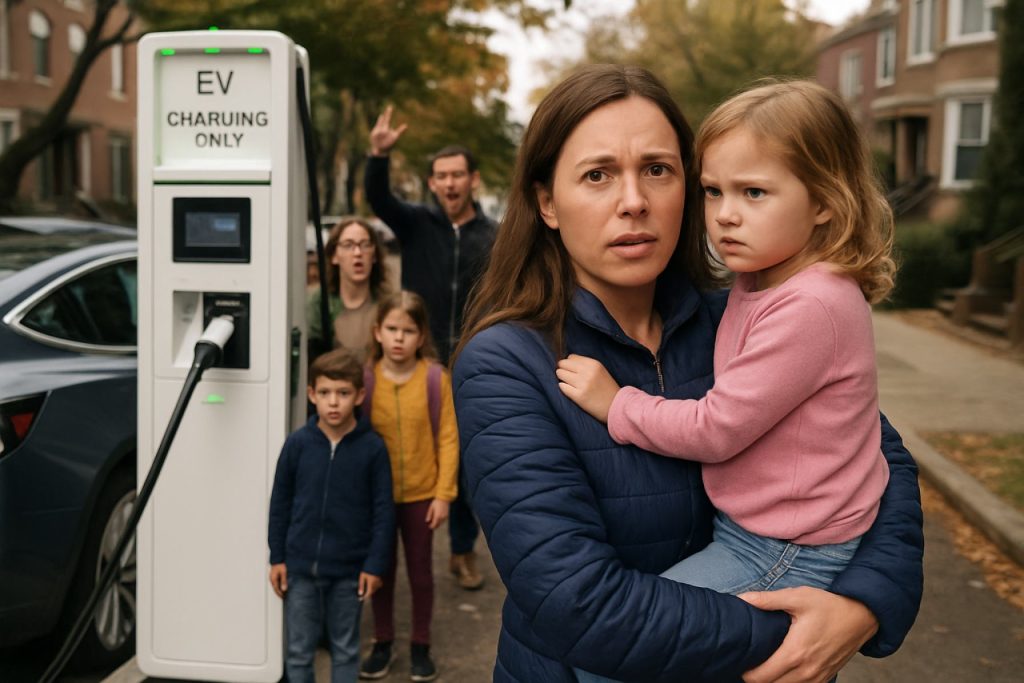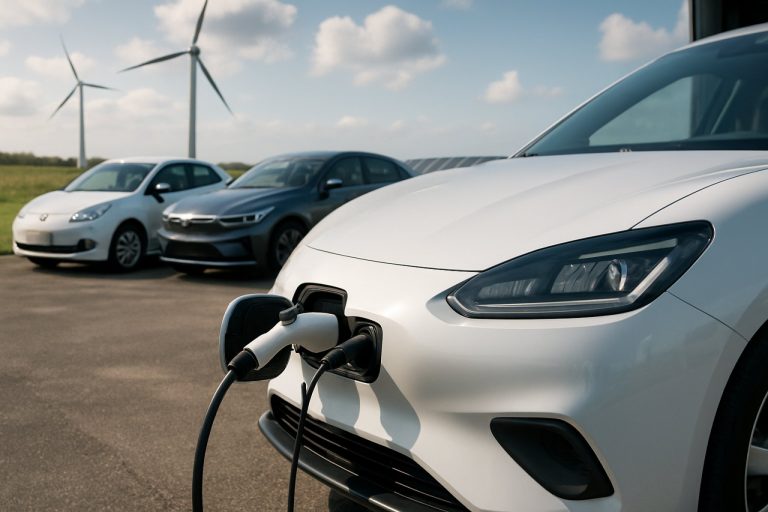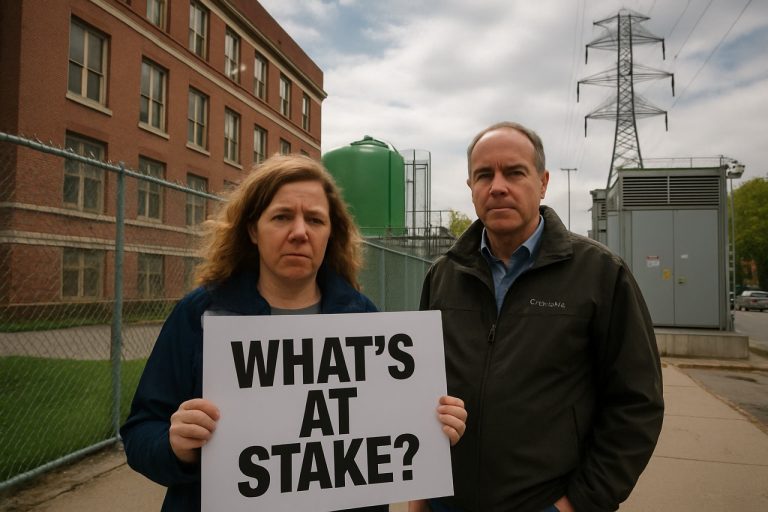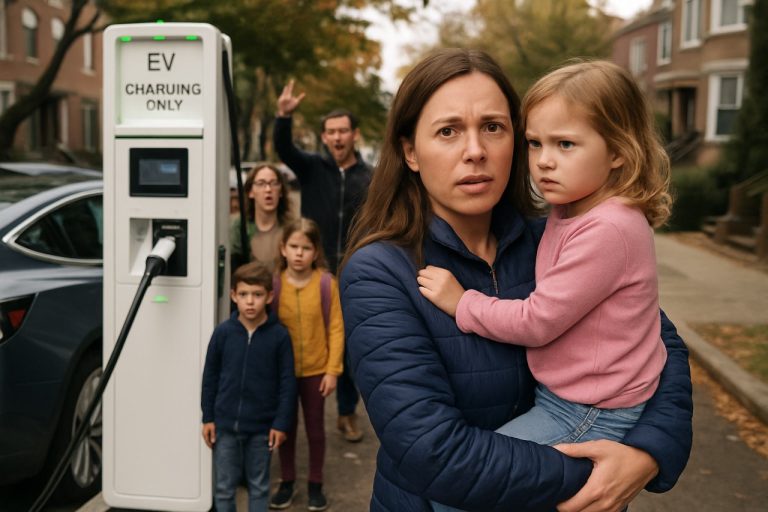
- New York City plans to build an EVgo electric vehicle charging hub at Fifth Avenue and 92nd Street, near PS/IS 104 in Bay Ridge, Brooklyn.
- Recent zoning reforms enable rapid expansion of green infrastructure, limiting community board opposition and streamlining approval processes.
- Local parents and community leaders express strong concerns about increased traffic congestion, pedestrian safety, and potential EV battery fire risks around the elementary school.
- Health worries also include electromagnetic field exposure, though scientific consensus finds typical charger emissions pose no known risk.
- Residents are calling for greater public input and prioritization of safety before development continues.
- The situation highlights the ongoing tension between urgent climate action and the need for local accountability as NYC pursues sustainability goals.
Heavy morning air pulses along Fifth Avenue, horns echoing as parents shepherd children across busy streets toward the brick facade of PS/IS 104 in Bay Ridge, Brooklyn. The block hums with routine — until the rumor of change splinters the calm. Plans for a state-of-the-art electric vehicle charging station, poised to rise across from the elementary school, have sent shockwaves through this tight-knit community.
According to city plans, the former KFC at the corner of Fifth Avenue and 92nd Street is slated to be transformed into an EVgo charging hub, part of New York’s aggressive push toward greener infrastructure. Recent zoning reforms, hailed by city leaders as a “City of Yes,” have streamlined the process, slicing through red tape and silencing community board opposition in favor of rapid green tech expansion.
But as excitement stirs in city hall, anxiety festers at street level. Parents of the more than 1,000 children enrolled at PS/IS 104 say their concerns are no match for bureaucratic zeal. They imagine a steady flow of vehicles vying for power, snarling already treacherous intersections, and increasing the risk of collisions in an area that’s seen its share of pedestrian accidents and near-misses.
Beyond traffic, the specter of fire — specifically, the intense blazes associated with lithium-ion batteries — haunts these conversations. Recent headlines have highlighted the challenge firefighters face when combating EV battery fires, which can burn hotter and longer than conventional car fires. While the National Fire Protection Association underscores that such events are statistically rare, the catastrophic nature of these fires amplifies neighborhood fears.
The debate transcends car counts and combustion risks. Whispers ripple among the playground crowds about electromagnetic fields and their potential health effects on growing children, though established science, including findings from the World Health Organization, maintains that typical exposure from properly installed chargers falls well below levels of concern.
Still, in Bay Ridge, facts and feelings collide. Community leaders have mobilized, penning stark letters to city officials and rallying support for a pause, if not a pivot, in the facility’s development. Their core argument crystallizes around a single, clear demand: safety and public input should not be steamrolled in the race to a cleaner tomorrow.
The EVgo project — backed by a $5.3 million land acquisition and silently advancing through municipal channels — now sits at the intersection of urgent climate action and local accountability. As New York City pushes toward electrification, with an eye on its ambitious sustainability goals (more details at nyc.gov), the outcome in Bay Ridge may echo far beyond one Brooklyn block.
The key question remains: Can progress and public safety coexist when change lands unexpectedly on a community’s doorstep? For the parents of PS/IS 104, the answer is as personal as it is urgent — and their voices are growing louder by the day.
EV Charging Stations Near Schools: What Bay Ridge Can Teach Us About Balancing Green Progress with Public Safety
Overview
The electrification of urban transportation is accelerating, and New York City’s plan to transform a former KFC into an EVgo charging hub across from PS/IS 104 in Bay Ridge shines a spotlight on the intersection of sustainability, community concerns, and city planning. While city officials push for rapid green energy solutions, residents demand greater safety and transparency. Here’s what you need to know, with fresh facts, industry insights, and actionable recommendations.
—
Additional Facts & Industry Insights
1. Growth in Urban EV Charging Infrastructure
– Market Forecasts: According to Allied Market Research, the global EV charging market is projected to reach $144.97 billion by 2030, reflecting the rapid rise in demand for public EV charging—especially in dense urban centers such as New York City.
– Real-World Example: Cities like Los Angeles and Amsterdam have demonstrated that strategically placed EV stations can double as economic revitalizers for underused lots, but careful planning is crucial near sensitive zones like schools.
2. Safety Concerns: Lithium-Ion Battery Fires
– Incident Statistics: The National Fire Protection Association (NFPA) confirms that EV fires are rare—estimated at 25 fires per 100,000 EVs versus 1,500 per 100,000 for gasoline vehicles (source: Insurance Institute for Highway Safety).
– Fire Response: Specialized training and equipment for firefighters are evolving. The FDNY, for instance, has introduced dedicated protocols for handling EV battery incidents.
– Security Upgrades: Modern charging stations include real-time fire detection, automatic shutoff systems, and remote monitoring—a significant improvement over early installations.
3. Health & EMFs: What the Science Says
– WHO Findings: Long-term studies, including those by the World Health Organization, consistently find no evidence linking EMFs from EV chargers to adverse health effects, given standard installation meets compliance regulations.
– Regulatory Oversight: U.S. Occupational Safety and Health Administration (OSHA) guidelines establish safe boundaries for EMF exposure in public and workplace settings.
4. Traffic & Pedestrian Safety
– Case Study: In San Francisco, traffic calming measures (like curb bump-outs and raised crosswalks) near EV stations have minimized accident risk, even at high-traffic intersections (source: San Francisco MTA).
– Best Practice: Requiring designated entry/exit lanes, posted signage, and off-peak installation schedules can keep children and families safe.
5. Zoning & Community Input
– City of Yes & Zoning: New York’s “City of Yes” reforms are designed to cut through bureaucratic inertia for green tech projects, but critics say speed should not trump feedback—especially in school zones.
– Controversy: Community boards often serve as essential voices for neighborhoods. Overriding them can sow distrust, as seen in Bay Ridge and elsewhere.
6. Features, Specs, & Pricing of EVgo Charging Hubs
– Capabilities: Fast chargers (Level 3/DCFC) can juice a typical EV 80% in 20–30 minutes, supporting major brands like Tesla (with adapters), Nissan, and Chevrolet.
– Costs: Charging rates at public stations vary. As of 2024, EVgo’s pricing in NYC ranges from $0.25 to $0.55 per kWh, with some membership discounts available (source: EVgo).
– Compatibility: Most modern EVs are supported; check manufacturer specs before use.
—
How-To Steps & Quick Life Hacks for Community Members
1. Stay Informed:
– Subscribe to local newsletters and alerts via nyc.gov.
2. Engage in the Process:
– Attend city council and community board meetings—even if zoning reforms have changed their formal power.
3. Advocate for Safety:
– Request traffic assessments from the NYC Department of Transportation.
– Demand enhanced street design (more crosswalks, speed humps) near the charging station.
4. Educate Children:
– Teach safe pedestrian practices around high-traffic areas and construction zones.
5. Monitor Health Concerns:
– Consult public health experts for additional, unbiased EMF guidance.
—
Reviews & Comparisons: EVgo vs. Alternatives
– EVgo: Fast, reliable, supports multiple EV brands, robust security systems.
– Competitors (e.g., ChargePoint, Tesla Supercharger): Some offer more network coverage or lower pricing for specific vehicles, but compatibility may vary.
– Limitation: All fast-charging facilities require significant grid capacity—sometimes necessitating transformer and utility upgrades that can extend project timelines.
—
Pros & Cons Overview
Pros:
– Accelerates clean energy transition.
– Reduces urban pollution.
– Convenient for local EV users.
Cons:
– May increase neighborhood traffic congestion.
– Requires proactive fire and traffic safety planning.
– Can provoke community pushback if input is overlooked.
—
Security & Sustainability
– Modern hubs deploy CCTV, lighting, and secure fencing for user safety.
– Sustainability: Many projects partner with solar or renewable energy providers to further reduce carbon footprint (source: U.S. Department of Energy).
—
Pressing Questions & Answers
Q: Will this EV station make my child less safe going to school?
A: Not if best-practice traffic and safety upgrades are executed alongside the installation. Insist on design adjustments and real-time monitoring.
Q: Can lithium-ion battery fires affect my neighborhood?
A: While possible, risk is statistically low and mitigated with updated fire-response protocols and advanced station technology.
Q: Is exposure to EMFs from chargers dangerous?
A: According to global health authorities, no—when compliant installation standards are met.
—
Predictions & Recommendations
– Industry Trend: Urban EV infrastructure will continue to expand, often near commercial corridors and high-traffic zones. Cities will need to balance pace and public trust.
– Actionable Tips:
– Petition for a formal safety review before installation.
– Advocate for a community liaison to report concerns during and after construction.
– Suggest pilot programs or phased rollout for new charging hubs near sensitive areas.
—
Conclusion
Bay Ridge’s experience reflects a broader dilemma: cities must aggressively cut carbon emissions while ensuring that local voices and safety are not lost in the transition. With robust public engagement, transparent planning, and proven engineering solutions, communities can enjoy the benefits of green infrastructure—without sacrificing peace of mind. For updates on zoning or sustainability programs, check out nyc.gov.
Quick Tip: If you live near a proposed EV charging hub, join your local neighborhood association and advocate for a Traffic & Impact Study before final permits are issued. Your input can shape a safer, cleaner future.
—
Further Reading:
– [U.S. Department of Energy](https://www.energy.gov)
– [National Fire Protection Association](https://www.nfpa.org)
– [NYC Official Portal](https://www.nyc.gov)
– [EVgo Network](https://www.evgo.com)



